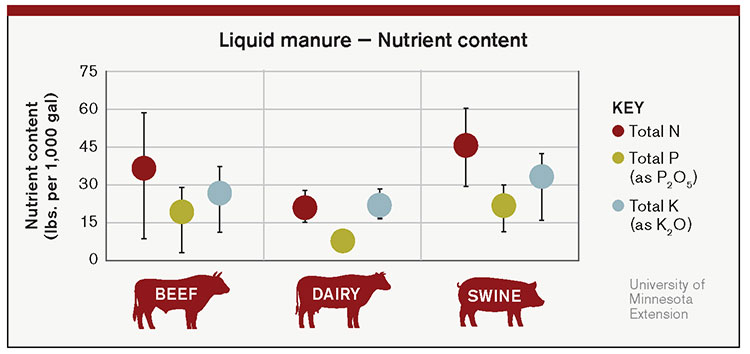
To make the most of manure that is going to be used as fertilizer, analyzing the nutrient content first is a must. Collecting a representative sample is key to this process.
“You want to get a sample before you apply in the fall so you know what you are dealing with,” said Melissa Wilson, manure management specialist with the University of Minnesota Extension. Wilson and Scott Cortus, a research manager at the university, shared the importance of collecting a representative sample and how to make a manure sampler for liquid manure in a short University of Minnesota Extension video.
“Nutrient content in liquid manure can be quite variable,” Wilson explained. She pointed to the figure that shows the wide range of nitrogen (N), phosphorus (P), and potassium (K) in manure. “The total N, P, and K variability illustrates the importance of getting samples taken from your own operation in order to better understand what nutrient concentrations you are actually applying to your fields,” she said.
Build your own tool
To collect a representative sample, a homemade manure sampler can be made using a PVC pipe. The pipe needs to be long enough to reach the bottom of the pit or storage area. Also needed is a rubber ball that is slightly bigger than the opening of the pipe, and an eye bolt to connect the ball to a piece of wire. Select a wire that has enough gauge to not only pull the ball tight to the end of the pipe but also enough strength to push it back out. The wire should be three or four feet longer than the PVC pipe.
A bucket will be needed to collect the bulk sample. Wilson said a 5-gallon bucket is useful because it has high sides that can help reduce splashing when manure comes out of the pipe. A mixing tool, like a ladle dedicated to manure sampling, is necessary to stir the manure and then fill the smaller sampling container. She also recommended a pair of rubber gloves to get this job done.
Taking the sample
To make the collection, Wilson said to first be sure the wire is pulled through the pipe but that the ball is loose. Lower the pipe into the pit until you reach the bottom, and then pick it up a few inches. “This will allow you to maneuver the ball into the pipe, and it also avoids the sludge at the bottom of the pit that you don’t pump out every year,” Wilson explained.
Pull the ball tight against the pipe, and then slowly raise the PVC pipe out of the pit, holding the wire taut so the ball doesn’t fall out. Once the bottom of the pipe is over the bucket, use the wire to push the ball out.
“We recommend collecting several samples, filling the bucket one-third to one-half of the way, to get the variability that may be found in that pit,” Wilson advised. If you have the opportunity, she also said to collect from several ports or places in the storage structure.
Once enough samples have been collected, mix the manure really well using the ladle, then pour some manure into the smaller sample container. Send several cups of material so the laboratory has enough to sample, but Wilson said to leave room at the top of the container for gases to escape, or if the sample will be frozen, allow room for the manure to expand so the container doesn’t explode.
Once the sample is ready, Wilson said to clean off the outside of the container, label it, and then double bag it to guard against leaks and spills during shipping. She recommended choosing a lab certified for manure analysis to ensure you are getting accurate results.
To watch the video “How to sample a liquid manure storage pit for nutrient analysis,” visit http://bit.ly/SampleLiqManure.
This article appeared in the November 2021 issue of Journal of Nutrient Management on page 16.
Not a subscriber? Click to get the print magazine.










